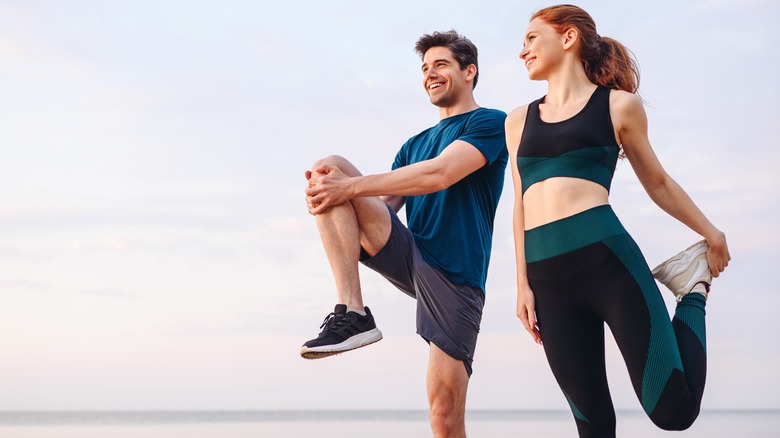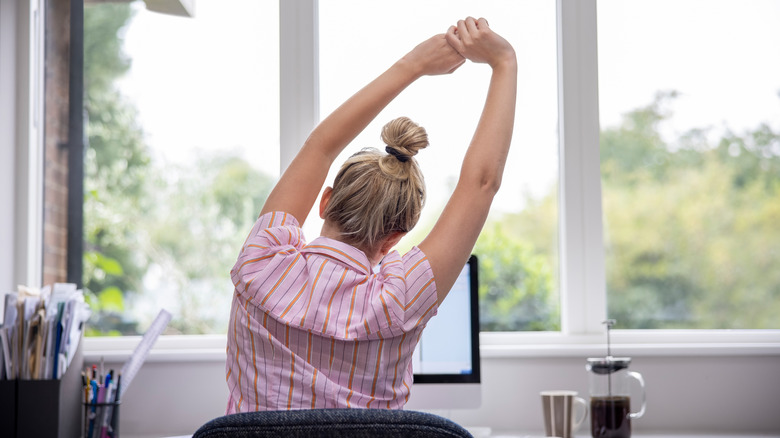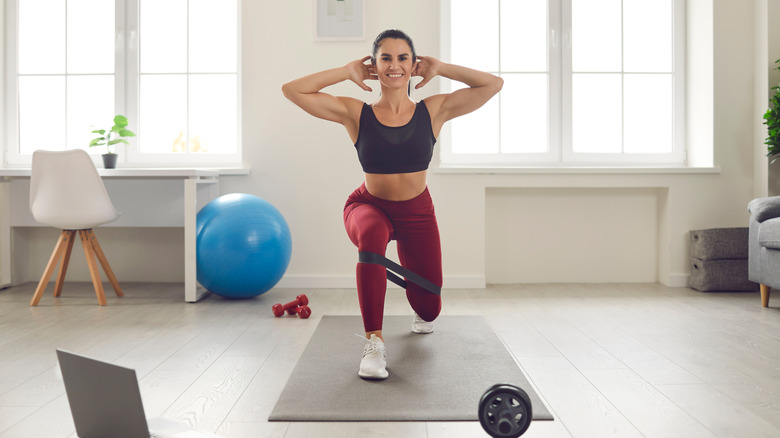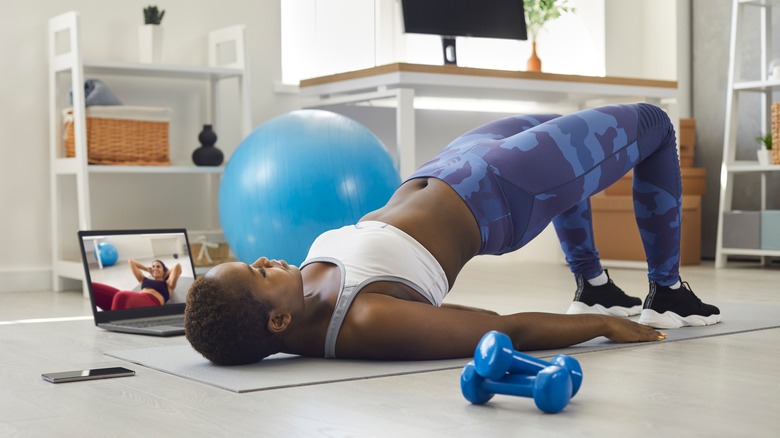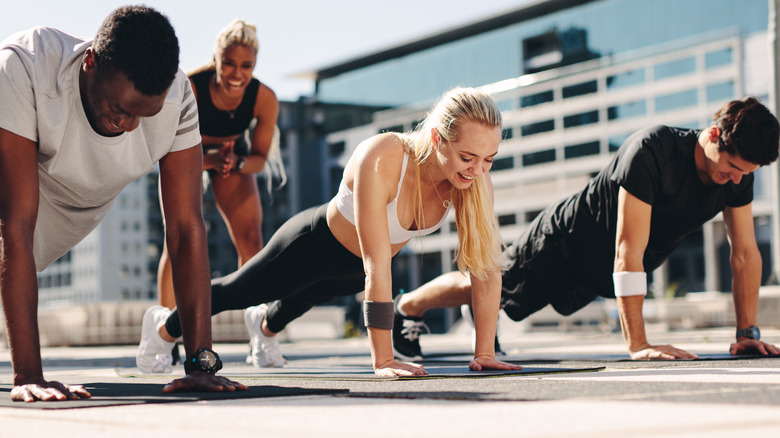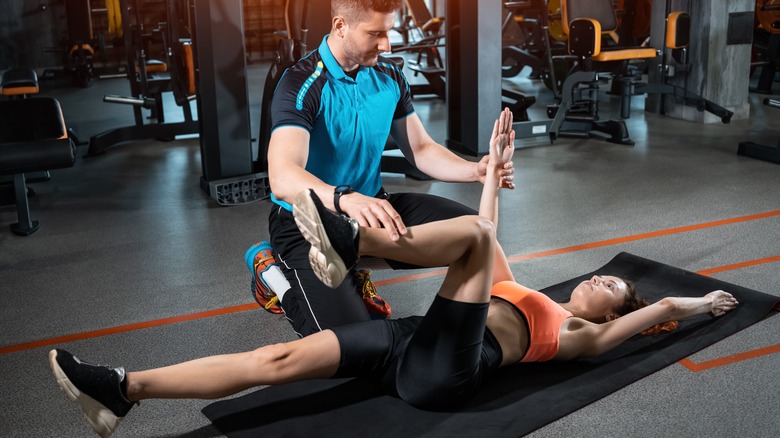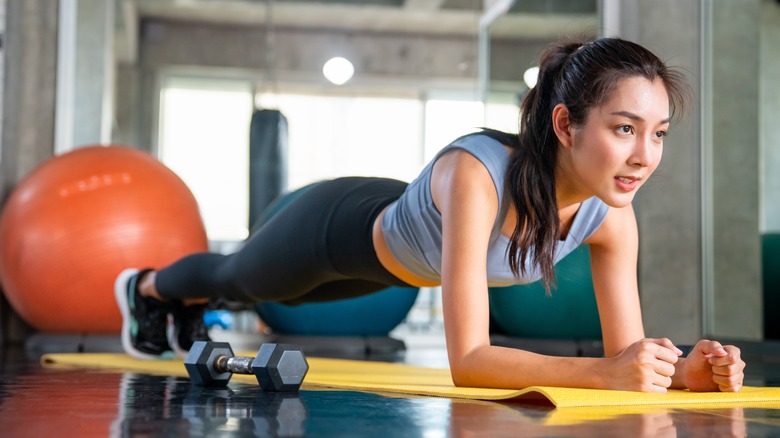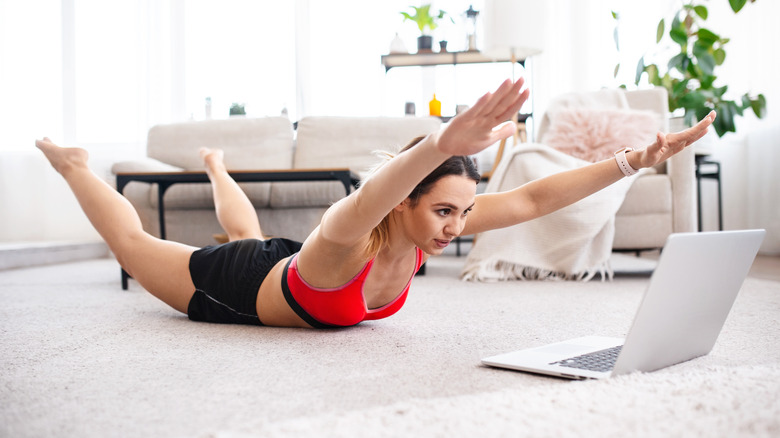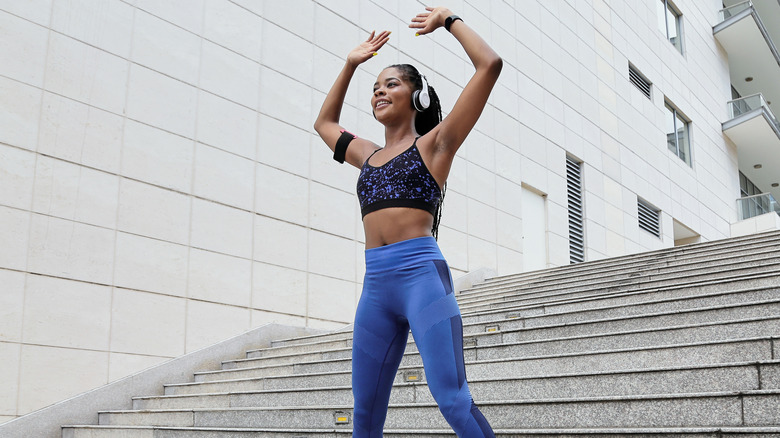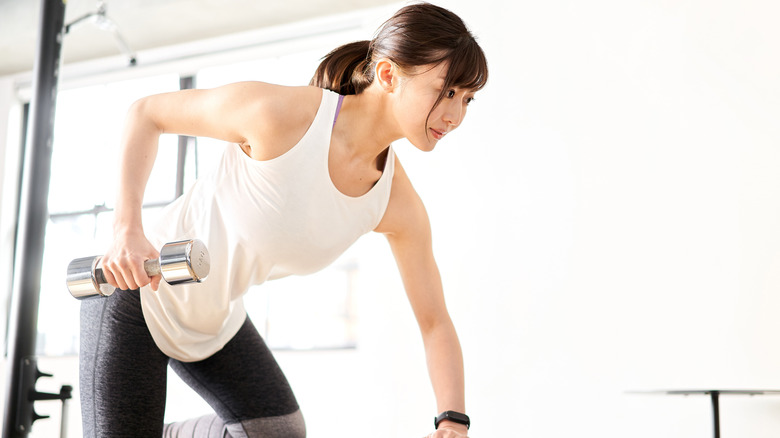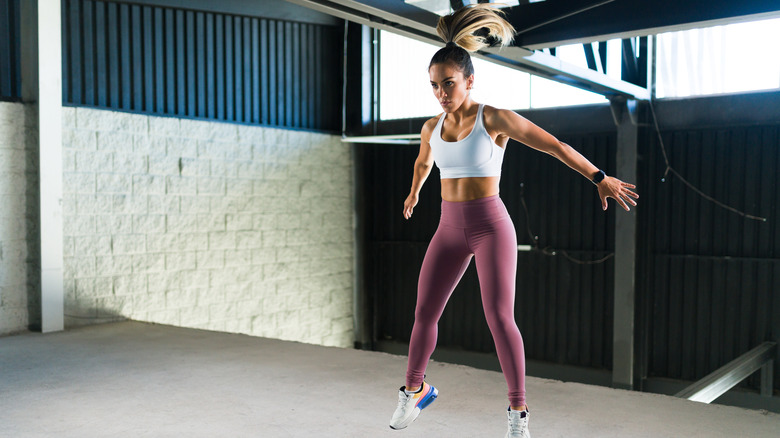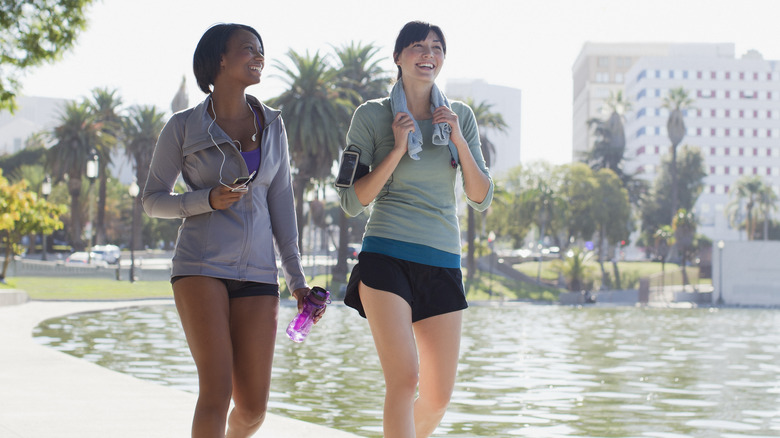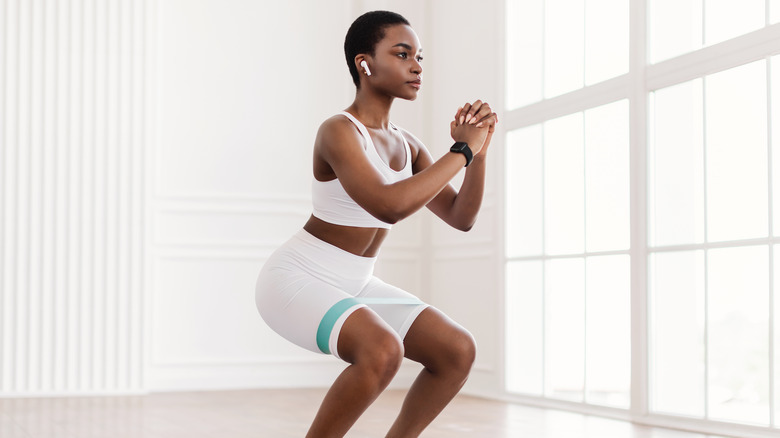Exercises You Can Do Every Day (And The Changes You'll See In Your Body)
We may receive a commission on purchases made from links.
Everyone knows that regular exercise is important for your physical and mental health. In addition to weight control and weight loss, exercise combats a number of health conditions ranging from high blood pressure and depression to Type 2 diabetes. Despite the numerous benefits of daily exercise, if you're new to fitness or struggling to break free from your sedentary lifestyle, it can be difficult to know where to start.
Making exercise a daily habit shouldn't be a punishment for eating or an hours-long commitment that causes you stress or pain. Instead, exercise should be enjoyable. It should be about helping you feel like your best self and improving your overall health. Shooting for a minimum of 150 minutes of moderate activity per week is ideal, and you can do this by mastering a few basic exercises that can be done anywhere.
No matter your age, weight, or current fitness level, if you're interested in starting a fitness regimen or looking to shake up your current at-home routine, the following exercises are simple, effective movements that you can do every day.
The importance of functional fitness
The majority of basic exercises can not only be done daily and from the comfort of home, but they also support functional movement. Functional fitness exercises are a type of strength training that supports everyday movement. When done properly, these exercises build strength in the body, improve your range of motion, and protect it from injury when doing basic movements like bending, pushing, pulling, and lifting.
"Think in terms of your daily routine," Director of Employee Wellness and certified functional strength coach Andy Gallardo tells Kaiser Permanente. "From crouching down in the garden to reaching high while shopping for groceries, you move in all sorts of ways every day. Functional fitness helps you stay strong and flexible as you go about your life... Even though younger people tend to be more flexible and avoid injury easier, functional fitness can benefit everyone. And it's especially good for people in their 40s and older." In other words, strengthening the muscles during a workout in the same way you actually use the muscles for normal activities is beneficial for improving your quality of life.
How to start exercising every day
Knowing which exercises to do and how to do them correctly is certainly important. But simply being familiar with the exercises isn't enough. If you have difficulty getting started or committing to a daily exercise routine that works for your lifestyle, there are a few basic tips you can follow to help get you started.
Experts agree that exercise doesn't have to be an hours-long affair. If you don't have more than 10 minutes at a time, piece together your workout until you can get in at least 30 minutes of total exercise. The benefits will be the same. You can also try fitting cardiovascular activities into times you would normally be sedentary. For example, doing sets of squats, planks, or push-ups can easily be done while watching TV or between meetings.
It is also important that you choose exercises that you like so you stick with them. "Begin by really thinking about the things you enjoy — nature, group settings, playing sports, quiet time, or being challenged. Then look for activities that meet one or more of your criteria," associate professor at West Virginia University's College of Physical Activity and Sport Sciences Dr. Kristen Dieffenbach tells Everyday Health. Choosing exercises that you feel you'd be good at or could become proficient at with time can also help you commit to an exercise routine.
Lunges
Lunges are an excellent multi-joint lower body exercise that unilaterally strengthens the muscles of the legs. "Lunges work multiple larger muscle groups at the same time," celebrity trainer Jillian Michaels tells Insider. "They build lower body strength and help to maintain muscle mass and bone density in the lower body." This includes the core, hips, quads, glutes, hamstrings, and calves. When done regularly, lunges improve balance and prevent future injuries. They also tone up the muscles in these areas and can help you build the thighs and butt of your dreams.
Proper form is necessary to garner the many benefits of lunges. First, stand with your feet shoulder-width apart with your arms at your sides or resting above the hips. Take one step forward, bending your knee as you do so, and lowering until your thigh is parallel to the floor. Make sure your knee doesn't extend past your foot. Lunges can be done standing in place or walking depending on your preference and the amount of room you have at your disposal.
Glute bridge
If you are hoping to strengthen and tone up your gluteal muscles, a glute bridge is an ideal exercise to perform. Glute bridges target similar muscles to squats such as the glutes, hamstrings, lower back, and core, all of which help with your general mobility. Unlike squats, this exercise doesn't put any pressure on the lower back or joints, making it a great choice for people with back or knee pain. Glute bridges make an excellent warm-up using just your body weight, but they can also be done with barbells or dumbbells for an extra challenge.
To do a glute bridge, you must first lay on your back with your feet planted on the floor, your knees bent, and your arms straight down at your sides. Your spine and pelvis should be flush with the floor. With slow, mindful movements, activate your core and push your heels into the floor while lifting your hips up towards the ceiling. Pause at the top of the movement before lowering back down slowly, focusing on touching one vertebra at a time to the ground. Perform three sets of 10 reps daily for maximum benefits.
Push-ups
Push-ups are a solid compound exercise, perfect for building a strong upper body. This simple but advanced movement builds a strong chest, biceps, triceps, shoulders, upper back, and core. "If done with proper form, push-ups can be great for our posture, putting us in good positioning instead of being hunched over or looking down..." Peloton instructor Olivia Amato tells Byrdie. "They help strengthen your core stabilization muscles, which are the foundation of any strength work we do and a key factor in getting stronger."
Although they look simple, push-ups require a lot of strength and proper form to execute. Thankfully, push-ups are as versatile as they are convenient. Depending on your fitness level, you may need to modify the exercise by dropping to your knees or bracing on a wall.
To do a standard push-up, get down on the ground in a tabletop position with your hands slightly wider than shoulder-width apart. Step your feet back until you are in a high plank, keeping them hip-width apart. Draw your belly button in towards your spine to engage your core and keep your body in a straight line. Bend the elbows and begin lowering the body towards the floor, ensuring your head, neck, and shoulders remain aligned with your spine throughout the movement. Push your body weight back up to straighten your elbows, which counts as one rep. Aim to complete around 15 reps per set.
Dead bugs
Dead bugs are a core exercise that targets the deeper, stabilizing muscles of your core, such as the transverse abdominis and the spinal erectors. It also targets the obliques and the pelvic floor. This means that, while it is unlikely to help you obtain shredded six-pack abs, it is extraordinarily effective for treating back pain, improving posture, and promoting overall core stability. A strong, stable core also means better balance and injury prevention as you age.
Dead bugs are relatively complex movements that require a strong mind-body connection to execute properly. Start by lying down with your knees bent. Lift both legs up into a tabletop position, ensuring your legs stay at 90-degree angles, and raise your arms up towards the ceiling. With a neutral spine, slowly extend one leg while lowering the opposite arm. Bring them back into starting position and perform the movement with the opposite leg and arm. Dead bugs are a beginner-friendly exercise, but you can modify them as needed to work within your fitness level.
Planks
Planks are a static bodyweight exercise ideal for engaging multiple muscles at a time, namely the core, shoulders, upper arms, and glute. When done alongside intentional diet and exercise, planks are also known to help reduce belly fat. Like most basic exercises you can do daily, it doesn't require any extra equipment. It simply involves holding the trunk of your body parallel to the ground. However, its difficulty can range from quick ab workouts to challenging tests of endurance.
To perform a plank, lay on your stomach like you were going to do a traditional push-up. Bend your elbows and keep your forearms flush with the ground and beneath your shoulders. Draw your belly button towards your spine to engage your core and hold the position for as long as you can. It is important not to let your head drop while you're in the plank position or to raise your butt. Instead, maintain a flat, straight spine and direct your gaze at the ground just ahead of where your hands are placed. If this intermediate exercise is too challenging for you, start with a plank from the knees.
There is no set number of reps, sets, or amount of time you should be holding a plank. Adding in a few rounds of planks at the end of a workout or to fire up your core muscles throughout your day will help increase your strength and meet your fitness goals.
Supermans
According to Pain News Network, roughly 72 million Americans suffer from chronic low back pain that interferes with their overall quality of life. While this pain can be caused by certain health issues, there has been an uptick in back and shoulder pain in recent years as people have shifted to working from home. Daily exercises like supermans are an effective way to combat the pain and stiffness from makeshift workspaces or sitting in an office chair all day long.
Supermans are a low-intensity exercise that helps you build mobility and strength in your back, core, and glutes. They also target the posterior chain, or the muscles that run down the backside of your body. "[These muscles] are all critical for everyday movement patterns- squat, hinge, push, pull, and carry," NASM-certified personal trainer Anne Reuss tells Shape. "You spend a lot of time in a flexed position [while] sitting in cars and [at[ your desk, so your posterior chain usually doesn't get as much love as it needs."
To perform a superman, lay on your stomach with your arms stretched over your head and your elbows at your ears. Engaging your core muscles and keeping your neck in a neutral position, begin to slowly lift both of your arms and legs up into the air. Hold this position for a couple of seconds before slowly lowering your arms and legs back to the ground. Repeat this movement between 12 to 20 reps per set.
Jumping jacks
For a quick full-body workout that gets your heart pumping and works multiple muscle groups, consider throwing in a few sets of jumping jacks into your daily routine. This basic plyometric exercise is both a cardiovascular conditioning exercise and a form of bodyweight strength training, both of which have major benefits for your body. "Jumping jacks have a wealth of benefits like mobility, increased blood flow, training in the frontal plane, and overall joint motion," strength and conditioning coach Jonathan Mike tells Insider.
Studies have found that jumping jacks can also help improve bone density, lower the risk of heart disease, and improve blood pressure in individuals that regularly do them. "Elastic strength is the ability for muscles and tendons to absorb and release energy," Alexa Javens NASM C.P.T. tells Nike. "The more elastic strength you have, the more powerful you'll be."
To perform a jumping jack, stand upright with your legs together and your arms resting at your sides. Jump into the air, spreading your legs outward and your arms upward over your head. As you jump your feet back in, lower your arms to complete one rep. You can increase the intensity of jumping jacks by adding in light dumbbells, increasing the tempo, or wearing ankle weights. Beginners or individuals with previous joint injuries can also modify the movement by stepping the feet in and out to avoid jumping.
Bent-over dumbbell rows
To combat tech neck and the hunched, poor posture it leads to, bent-over dumbbell rows are an effective daily exercise to throw into your rotation. Rows are a foundational movement that help build strength and mobility in the upper back and shoulders, with some emphasis on the biceps, abs, and lower back.
Bent-over dumbbell rows are a beginner-friendly movement. Begin in a standing position with one dumbbell in each hand. If you don't have a set of dumbbells at home, you can use cans of soup or gallons of water to perform the movement. Hinge forward at the hips until your upper body is almost parallel with the floor and keep a soft bend in your knees. Keep your shoulders pulled down and away from your ears as well. Then, squeeze your shoulder blades together and pull the dumbbells up toward your hips. Lower down to complete the rep, and aim for 10 to 12 reps per set.
There are also a number of variations to this simple movement, including single-leg bent-over rows and plank rows. As your body grows stronger and you crave an extra challenge, experiment with the different variations.
Burpees
For a more advanced cardio and strength training exercise, burpees are an effective form of movement that requires little to no space and burns more body fat quickly. "Burpees are a total body movement," Alexis Dreiss NASM CPT tells Women's Health. "You work through a hip hinge, knee [movement], and pushing motion all in one. You're getting a true bang for your buck." When done properly, this exercise works the shoulders, arms, glutes, hamstrings, quads, calves, and core.
To do a burpee, start in a standing position. Squat down until your hands touch the floor and jump your back into a high plank. From the plank, jump your feet back up by your hands and stand up straight. Alternatively, you can add a jump at the top of the movement for an extra challenge. Burpees alone shouldn't be your go-to exercise for weight loss or strength training, especially if you are new to fitness and strength training. However, adding them to your regular fitness routine is a great decision for your health and well-being. Dreiss recommends no more than 10 to 12 reps for up to four sets at a time.
Go for a walk
If burpees or running on a treadmill aren't your idea of fun, opting for a daily walk is just as beneficial in the long term. Walking is an ideal, uncomplicated exercise that anyone can do. Its numerous benefits include helping maintain a healthy body weight, lose body fat, manage or prevent health conditions like diabetes or high blood pressure, and ultimately improve cardiovascular fitness. "As you continue to walk, you may notice your pants begin to fit more loosely around your midsection, even if the number on the scale isn't moving much," Dr. Melina B. Jampolis, M.D., tells Prevention.
Furthermore, daily walks strengthen your bones, muscles, and joints. A study published in the "American Journal of Preventive Medicine" supports this, finding that adults 49 and older who had low-body pain and walked a minimum of one hour per week were less likely to develop disabilities as they aged. Walking also improves mood and energy levels, so much so that incorporating a brisk walk into your daily routine can actually improve brain function due to increased blood flow to the brain. Best of all, walking is free and accessible.
Squats
Perhaps the most effective strength training exercise you can — and should — do daily are squats. This functional exercise is important for maintaining optimal joint and muscle health in the muscles you use every day. Regular squats target the quads, hamstrings, glutes, and core while supporting the joints in the hips, knees, and ankles. Some research also suggests that doing squats every day can help reduce cellulite, firm the skin of the legs, and tone up the look of the lower body. It will also help prevent injuries from everyday movements like bending, lifting, and picking up heavy objects.
Depending on your body shape, start the squat stance by standing with your hips somewhere between hip- and shoulder-width apart and your toes pointed slightly outward. Maintain a neutral spine and a lifted chest, and keep your gaze forward throughout the movement. To perform a squat, send your hips back as if you are sitting down in a chair and press through your heels, bending your knees as low as possible in a slow, controlled motion. The goal is to get your thighs parallel to the floor. However, if you can't lower that far down without lifting your heels, curving the upper body forward, or losing your balance, focus on smaller movements until you can build up strength.
